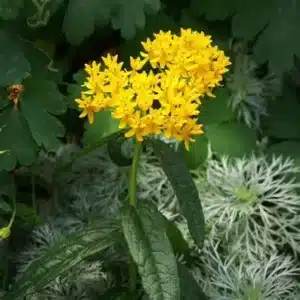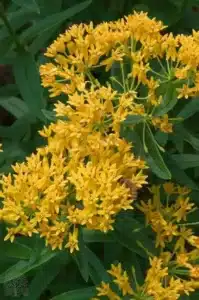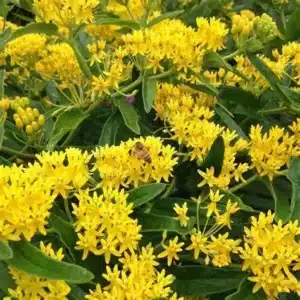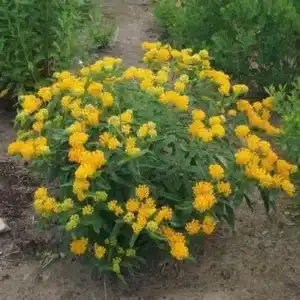Butterfly Weed, Yellow Milkweed, Pleurisy Root, Tuberous Swallowwort, Indian Paintbrush






Propagating Butterfly Weed can be successfully done by harvesting its seeds, cuttings, or division. To propagate from seeds, collect the mature seed pods after they dry out on the plant, carefully remove the seeds from their fluff and store them in a cool, dark place. Prior to sowing, these seeds should be soaked in warm water for twenty-four hours to encourage germination. Follow this by planting one inch deep in a well-drained soil, ensuring the seed has sufficient exposure to light. If propagating through cuttings, select a healthy, new-growth stem cutting in the spring or early summer, remove the bottom leaves, dip the cutting edge into rooting hormone powder and plant it in a pot. Alternatively, you can propagate Butterfly Weed by division during its dormancy period, by digging up the whole plant gently, separating it into smaller portions, ensuring each fragment has sufficient roots, and replanting it immediately. Regardless of the propagation method chosen, once Butterfly Weed is properly placed, water it adequately, ensuring it does not stand in water or dry out completely, and allow it full sun for optimal growth. Fertilizing with a balanced plant food twice a month will aid in its vigorous growth. Protect your planting from strong wind, and be patient, as Butterfly Weed may take time to establish.
The Butterfly Weed, an exquisite variety of Asclepias tuberosa, requires full sun and well-drained soil to flourish. In spring, initiate watering when the soil becomes dry to touch, ensuring you water the plant thoroughly without making it waterlogged. Avoid overwatering. When summer comes, water the Butterfly Weed once a week if rainfall has been low. Supplement the soil with an all-purpose, slow-release granular fertilizer to provide it with optimum nutrients. By fall, lessen watering frequency as the plant is preparing to go dormant for winter. It’s optimal to stop feeding the plant during this period to support its natural preparation for dormancy. Make sure to leave the wilted stalks intact, as they provide the necessary insulation and attraction for wintering butterflies. During winter, do not water the plant and avoid covering the area with mulch as the Butterfly Weed prefers colder conditions. Let the snow cover it naturally. Pruning back old growth in late winter or early spring will encourage fresh growth come the warmer months. Prevention of pests and diseases can be achieved by ensuring good air circulation and practicing proper watering techniques to avoid overly wet conditions, which can lead to fungal diseases.
As a butterfly weed owner, it is crucial to use a balanced, slow-release granular fertilizer with NPK values of 10-10-10 or 14-14-14 if your soil tests indicate average fertility. Apply the fertilizer once in the early spring just before the new growth starts. When applying, sprinkle the granules around the base of your butterfly weed, staying approximately 6 inches away from the stem to avoid burn. Water thoroughly, ensuring the nutrients are absorbed deep into the soil and readily available to your plant. If your soil test results indicate your native soil is exceptionally infertile, you might consider a slightly higher phosphorus and potassium fertilizer with an NPK ratio like 10-20-20. An annual application should be sufficient as excessive fertilization can promote more foliage growth at the expense of flowering and compromise the overall health of your butterfly weed.
The Butterfly Weed is a perennial plant that typically does not require rigorous pruning, but selectively thinning out the plant aids in preventing overcrowding and encourages a healthier and more prolific bloom. The best time to start pruning is at the beginning of spring, just as new growth begins. Use clean, sharp tools to selectively remove older, weaker stalks at the base of the plant to allow for new shoots. Refrain from pruning during the summer and early fall as this is the plant’s blooming period and the plant attracts butterflies during this time with its bright yellow flowers. It is also vital to suspend pruning once you notice seed pods forming to permit seed dispersal, thus helping the species continue to thrive and multiply. Finally, remember not to do any drastic pruning at any time to prevent plant stress.
Butterfly Weed can experience a variety of pest problems. The most common insects that feed on it are aphids and milkweed bugs, which can be identified by their small size and brightly colored bodies. Aphids can be green, yellow, or black and cluster on stems and leaves, while milkweed bugs are generally red or orange with black markings. These pests suck sap from the plant, hindering growth and potentially spreading disease. Treating them can be done by introducing natural predators, like ladybugs, or using an insecticidal soap. Make sure to apply it in the early morning or late evening to prevent leaf burn. Butterfly Weed can also succumb to diseases such as root rot, mildew, and rust. Symptoms include yellowing leaves (root rot), white powdery growth (mildew), or orange spots on the under surface of leaves (rust). To avoid these diseases, ensure the plant is properly ventilated, avoid overhead watering, and maintain a clean environment by removing dead leaves and stems. If infected, treat with a suitable fungicide or consider removing the plant entirely to prevent the spread of disease.














